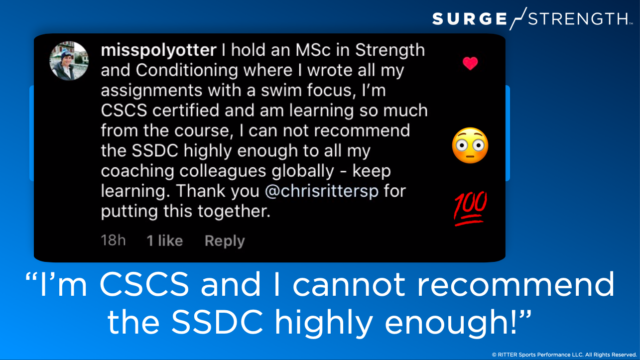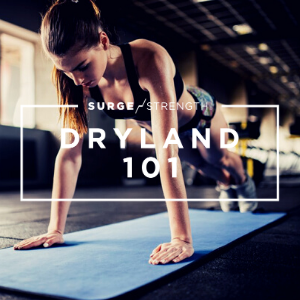Doing swim specific plyometrics for swimming can dramatically improve your starts and turns. It can be hard to gauge just how effective you’re being off the block and off the wall. The other problem is that many people can’t practice their starts or even get in a pool right now. How can your turns improve without practicing them in the water?
Fortunately, SURGE Strength is here to let you in on a secret: we have been training these concepts without water for years. By incorporating plyometrics for swimming into your dryland program, you can reap the benefits of power training without any equipment needed. Work on your reaction time, starts, and turns with the help of gravity, the floor, and your own bodyweight. In this article, we break down how to correctly perform our favorite jumps and how to make them more swim specific.
Incorporating Plyometrics for Swimming into Dryland
Power-based jumps are great tools for a dryland program when applied appropriately, which include plyometrics for swimming. If you haven’t jumped in a while or are just starting to incorporate jumping into your program, it’s important that you don’t overdo it. Otherwise, the risks outweigh the reward. Consider keeping track of your foot contacts as you go through these jumps. Beginners should keep their foot contacts to about 10 landings total per session. For athletes that are used to high impact activity, the recommended amount of foot contacts jumps to about 20 reps or less per session. Keep in mind that the purpose of performing plyometrics is to build explosive power as opposed to using them for conditioning purposes.
Learn How to Jump
Before programming jump variations into your dryland plan, it’s important to develop proper jump and landing mechanics. Any jump you train puts the muscles on a slight stretch followed by a quick shortening. As you land, your body learns how to absorb impact. It’s possible that if you aren’t used to high impact activity, have never learned how to jump properly, or are recovering from an injury, you need to work on some jump drills before letting your feet leave the ground. Watch the video below to see SURGE Strength’s favorite jump progression drills:
As you work through these drills, be sure to focus on hip drive and triple extension. Sinking the hips as you bend your knees, then pulling the hips through as you jump helps you go higher. In addition, this correlates directly to more powerful hip drive with each stroke. The triple extension at the hip, knee, and ankle strengthens the muscles at each joint and improves kinesthetic awareness. In turn, you will notice stronger, faster turns in the pool. Knowing how to jump is an essential skill for both overall athleticism and the sport of swimming.
Broad Jumps
Broad jumps unlock potential for your starts as well as increase overall power in the water. Make sure you have proper space for these jumps. Remember, the purpose of these jumps is to travel horizontally as far as possible. Ideally, you will be able to jump the length of your height. Work through some of our favorite broad jump variations by following along with the video below:
Swim-Specific Broad Jump Variations
In order to make these jumps more swim-specific, add a reaction component or change your start position. For example, start with your feet in a staggered stance like you are on the starting block. Place your hands on the floor in front of you, just like you would for your swim start. Have a friend say, “take your mark, go” before each rep. On the word go, explode into the jump (landing on your feet of course) working on your reaction time. As you try these variations, try not to compromise the mechanics or effectiveness of the jump. To help with this, reset and take a second before each rep. This way, you’re focusing on quality over quantity. Lastly, be sure to fully recover from each set so you reap the benefits of training power as opposed to using this exercise as another form of conditioning.
Squat Jumps
Vertical jumps (such as squat jumps) help you to push off the wall faster and to improve hip power in the kick. They also work on overall power, coordination, and stability. This movement has the same set up, countermovement, and landing mechanics as our broad jumps. However, squat jumps train for height rather than distance. Incorporate some of the amazing squat jump variations from our video below into your dryland program:
Swim-Specific Squat Jump Variations
Like the broad jump, you can add in a reaction piece to your squat jump. By “sending” yourself into each jump with a reaction cue, you are improving your brain’s ability to react to a stimulus and tell the body to move. This translates directly into your swim starts and improves neural activity in the brain. In addition, you can add a streamline position with the arms at the top of the jump. This trains your muscle memory to whip the arms into streamline as fast as possible on the start.
For a challenge, keep the arms in streamline as you land. You will notice how challenging it is for your core stabilizing muscles to maintain that proper streamline while absorbing force from the jump. As you work through these variations, be sure not to compromise form for complexity of the exercise. For instance, you may find that just focusing on the legs gives you more benefit than trying to add in the streamline position. Remember, the primary purpose of the exercise is to improve lower body power. The upper body position is just a bonus benefit of this training.
Other Considerations
As you work through incorporating these jumps into your dryland program, consider using some of the single leg variations demonstrated in this video. There are many benefits to unilateral training including an increase in overall power, ankle stability, and increased body awareness. In other words, training on one leg will make you stronger for exercises using both legs. Use caution when jumping on one leg and be sure to alternate legs accordingly with each set. This way, you won’t overdo these movements and risk an injury.
Jumping is a critical skill for building overall coordination, power, and athleticism. Now is a great time to progress your jumping ability. Regardless of your age or stage in the sport, it’s never too late to benefit from plyometric training for swimmers. Jumping helps build gross motor skills in youth athletes. It also decreases the risk of falling in older mater’s athletes. The best part is you only need your body and gravity to progress this skill. Add in these plyometrics for swimming variations and see how well they translate into the sport of swimming.
NEW – AT HOME DRYLAND WORKOUT
GET IT FOR FREE BY ENROLLING IN THE SURGE STRENGTH ACADEMY
JOIN OTHERS FROM AROUND THE WORLD THAT ARE
BECOMING SURGE STRENGTH DRYLAND CERTIFIED (SSDC)

BECOME SURGE STRENGTH DRYLAND CERTIFIED (SSDC)
BUILD BETTER ATHLETES TO GENERATE FASTER SWIMMERS
Courtesy of SwimSwam’s exclusive dryland training partner, SURGE Strength.
SURGE Strength, a strength training brand created by Chris Ritter, CEO of RITTER Sports Performance, aims to build better athletes and faster swimmers through dryland programs, and coaching education.







